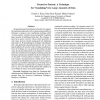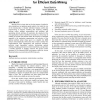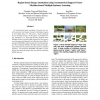VISUALIZATION
1995
IEEE
14 years 4 months ago
1995
IEEE
Animportantgoalofvisualizationtechnologyistosupport the exploration and analysis of very large amounts of data. In this paper, we propose a new visualization technique called ‘r...
KDD
1997
ACM
14 years 4 months ago
1997
ACM
This paper presents an autonomous algorithm for discovering exception rules from data sets. An exception rule, which is defined as a deviational pattern to a well-known fact, exhi...
ICPR
2010
IEEE
14 years 4 months ago
2010
IEEE
—The problem we address in the paper is how to learn a joint representation from data lying on multiple manifolds. We are given multiple data sets and there is an underlying comm...
KDD
2000
ACM
14 years 4 months ago
2000
ACM
In this paper we introduce the Generalized Bayesian Committee Machine (GBCM) for applications with large data sets. In particular, the GBCM can be used in the context of kernel ba...
KDD
2000
ACM
14 years 4 months ago
2000
ACM
Having access to large data sets for the purpose of predictive data mining does not guarantee good models, even when the size of the training data is virtually unlimited. Instead,...
ALT
2000
Springer
14 years 4 months ago
2000
Springer
In this paper1 we propose a new algorithm for providing confidence and credibility values for predictions on a multi-class pattern recognition problem which uses Support Vector mac...
EDBTW
2006
Springer
14 years 4 months ago
2006
Springer
The wavelet decomposition is a proven tool for constructing concise synopses of massive data sets and rapid changing data streams, which can be used to obtain fast approximate, wit...
ECML
2006
Springer
14 years 4 months ago
2006
Springer
Abstract. In their search through a huge space of possible hypotheses, rule induction algorithms compare estimations of qualities of a large number of rules to find the one that ap...
CVPR
2006
IEEE
14 years 4 months ago
2006
IEEE
In region-based image annotation, keywords are usually associated with images instead of individual regions in the training data set. This poses a major challenge for any learning...
FGR
2004
IEEE
14 years 4 months ago
2004
IEEE
We present a new unsupervised learning technique for the discovery of temporal clusters in large data sets. Our method performs hierarchical decomposition of the data to find stru...



